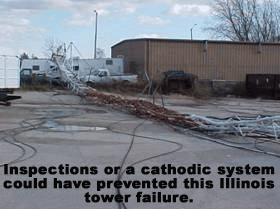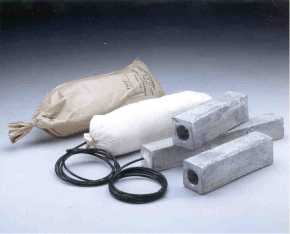
Product Information
Anchor Protection Systems
In an obscure finding during 1824 while experimenting with electromechanical science, Sir Humphrey Davy discovered that by using iron anodes he was able to protect the rapidly decaying copper sheeting on His Majesty’s ships from seawater corrosion. From that beginning, long before its theoretical foundation was established, cathodic protection (CP) has grown to have many uses in marine and underground structures, water storage tanks, gas pipelines, oil platform supports and many other facilities exposed to a corrosive environment, such as guy tower anchors. copper sheeting on His Majesty’s ships from seawater corrosion. From that beginning, long before its theoretical foundation was established, cathodic protection (CP) has grown to have many uses in marine and underground structures, water storage tanks, gas pipelines, oil platform supports and many other facilities exposed to a corrosive environment, such as guy tower anchors.
Unfortunately, an unacceptable percentage of newly constructed guy towers have been installed without a quality CP system in areas where there is low soil resistivity at the anchors. In addition, a considerable inventory of towers with deadman anchor shafts buried below ground may be at risk as some owners have recently discovered after their guy tower collapsed. The Electronic Industries Association committee responsible for writing the standard entitled Structural Standards for Steel Antenna Towers and Antenna Supporting Structures (EIA/TIA-222-F) has been engaged in studying this issue and changes to the standard in this regard will appear in Revision G slated for introduction in 2005.
 Many steel anchor shafts are galvanized or epoxy coated to prevent corrosion while earlier coating specifications only required a bitumen-based application. The zinc in a hot-dipped galvanized coating will serve as a protective anode to the steel shaft for a time, but should not be considered as adequate protection in an underground environment. An epoxy coated shaft will protect the steel from direct exposure to the electrolyte. However, if the coating has been damaged during backfilling or chipped during installation, a small void will facilitate accelerated corrosion in that location. A tar-based coating can assist in encapsulating moisture to allow for quick corrosion that is not easily detectable. Many steel anchor shafts are galvanized or epoxy coated to prevent corrosion while earlier coating specifications only required a bitumen-based application. The zinc in a hot-dipped galvanized coating will serve as a protective anode to the steel shaft for a time, but should not be considered as adequate protection in an underground environment. An epoxy coated shaft will protect the steel from direct exposure to the electrolyte. However, if the coating has been damaged during backfilling or chipped during installation, a small void will facilitate accelerated corrosion in that location. A tar-based coating can assist in encapsulating moisture to allow for quick corrosion that is not easily detectable.
Sacrificing for a greater cause
Cathodic protection using sacrificial anodes has become one of the most widely used methods of preventing the corrosion and deterioration of metallic structures in contact with any forms of electrolytically conducting environments, i.e. environments containing enough ions to conduct electricity such as soils,  concrete, seawater and basically all natural waters. concrete, seawater and basically all natural waters.
Cathodic protection reduces the corrosion rate of a metallic structure by reducing its corrosion potential, bringing the metal closer to an immune state. The two main methods of achieving this goal are by either using a sacrificial anode (positive) with a greater corrosion potential, such as magnesium, and connecting it to the anchor shaft cathode (negative), or by using an impressed current provided by an external current source. Providing sacrificial anodes is the most economical and most widely used method for protecting guy tower anchor shafts.
Some manufacturers will identify the number of anodes required by extrapolating the shaft and fan plate’s square footage based upon the width of the face of the tower.
 The following average pricing for a sacrificial anode system is based upon a three anchor guyed tower. Increase your pricing for a six or nine anchor structure. Pricing does not include tax, freight or installation. Test heads, one per anchor, are sold separately or can be included in a kit. The following average pricing for a sacrificial anode system is based upon a three anchor guyed tower. Increase your pricing for a six or nine anchor structure. Pricing does not include tax, freight or installation. Test heads, one per anchor, are sold separately or can be included in a kit.
|
Cathodic Protection Systems
|
| Tower Face |
Sacrificial |
Average |
3 Test |
| Width |
Anodes |
Pricing |
Heads |
| 18" or less |
3 |
$908 |
$560 |
| 19" to 60" |
6 |
$1,391 |
$560 |
| 61" or more |
9 |
$1,759 |
$560 |
We recommend that you contact our valued anchor protection system manufacturers and distributors for your site-specific requirements.
|